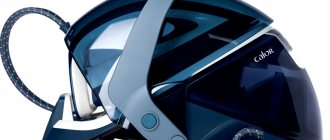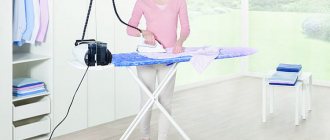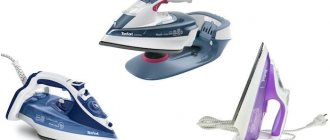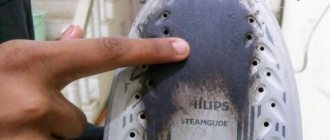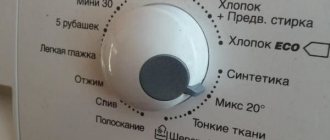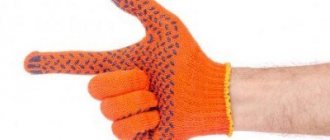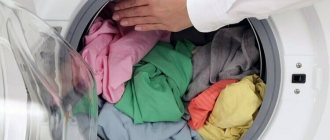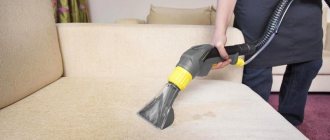How to use?
The operating principle of a vertical steam iron is quite simple:
- Cold water is poured into the tank, then the device is connected to the power supply. The device has a regulator on which you can set the desired steam supply mode.
- The water in the container heats up in 1-2 minutes, after which the evaporation process begins. Steam comes out of special holes on the base of the device. When you press the button, a burst of steam is generated from them.
- To smooth the item vertically, you need to hang it on hangers. While slightly stretching the fabric with one hand, move the device from top to bottom in the other hand. Since steam penetrates deep into the fabric, it is enough to smooth the item on one side.
To iron trousers and jeans, it is convenient to use a hanger with special clips. Curtains must first be hung, and only then ironed.
Some of the models with vertical ironing function have several steam modes. They are separated by steam supply power intended for different types of fabrics. Slightly cheaper models have one mode. In practice, housewives use only 1-2 modes, so if the device is purchased for home use, it is not necessary to choose an expensive model with different modes.
The possibilities of ironing with vertical steam are demonstrated in the video using the example of Rowenta irons:
What is a steamer?
A steamer is a device that uses steam to smooth fabric. You can use a steamer when caring for clothes and home textiles.
The principle of operation of the steamer is that hot air penetrates the fabric and straightens it. Just a few, and sometimes just one movement, and you no longer see the folds.
This effect is possible thanks to the steam generator built into the steamer. It receives steam from water, which, under pressure, penetrates the fibers to straighten them.
Also read: How to use a toaster: what it is and what it can do
Technical features
Before figuring out how to properly use a clothes steamer, it’s a good idea to understand its internal structure.
The structure is usually made up of parts:
- Steam generator. And next to it is a heating element, a boiler, and a pump that supplies water.
- Water container.
- Hose.
- Iron.
- A holder or other item for hanging clothes.
As a rule, the latest models have an accessible control panel, to the delight of the user. Including buttons that allow you to adjust the steam strength. We recommend buying a steamer complete with a holder, so that you don’t have to worry about where to hang the item.
Differences from iron
Perhaps this question worries many users; no one wants to spend money on something that will then lie idle. So, what do steamers have that an iron doesn’t?
Firstly, it’s true that the iron is also equipped with a steaming function, but its sole always comes into contact with the fabric, and you can easily ruin it.
Using a steamer, even with delicate fabric, this will not happen. The device contacts the fibers only through steam.
Also read: Refrigerator does not work: cause and troubleshooting
Other differences between a steamer and an iron:
- This new device is suitable for caring for any fabric. It can be the usual knitwear, synthetics, wool, leather.
- You can use a hand steamer in a vertical or horizontal plane. This is much more convenient, especially if you need to iron outerwear or curtains.
- The steamer leaves no residue. You won't see shine, extra folds or creases, even if you have a super thin, fleecy or delicate item.
- Steaming is faster than ironing.
Power and pressure of vertical steam irons
Modern models mainly have a power of 1.6-2.4 W:
- 1.6-2 kW - suitable for home use if the family is small or there is not a large amount of clothing. Works great on shirts, coats, dresses and other soft fabrics.
- 2.1-2.4 kW - such a device is suitable for large volumes of work. It even copes with heavy curtains, jeans, and down jackets.
The higher the power of the device, the better it copes with its direct function. In addition to this parameter, the devices differ in the pressure of the steam they produce. For light fabrics, 35-60 g/min is sufficient, and for heavy and dense fabrics, a higher figure will be required.
What power to choose a device depends on the volume and purpose of its use. If you plan to use it for home use, you can get by with the average. If the iron is bought in a studio or clothing store, you need a more powerful device.
Steam iron sole
For the horizontal type of ironing of clothes, the quality of the soleplate of the iron is important, because in practice, housewives use both vertical steaming and horizontal conventional ironing of clothes. They are mainly produced in several types:
- Aluminum . Quite light, your hands do not get tired when working with such a device. Disadvantage: vulnerability (easily deformed).
- Stainless steel . Durable material that does not require effort to maintain. The disadvantage is the most severe compared to other materials.
- Ceramics . It reliably protects fabrics from burning and glides easily over the surface, but this material is considered one of the most fragile and difficult to care for.
It is recommended to choose an iron with vertical steaming, the sole of which is made of combined materials. And, of course, it is important to pay attention to the number of holes for steam to escape on the sole: the more there are, the easier and faster ironing of clothes will be.
Optimal characteristics of an iron with a steamer
There are not many characteristics that you should pay attention to, but all are important because... each affects the quality of ironing and the safety of things.
Power
It is based on a heating element - heating element. The amount of electricity consumed and the heating time to the required temperature depend on its power.
Devices are divided according to power into three groups:
- Up to 1500W – they are not particularly popular because are not able to cope with some types of fabrics and require more time to iron. Low-power steam irons for clothes are convenient to take with you on a trip due to their small size and weight.
- 1800-2400W - average power, works great with any type of fabric and is ideal for home use.
- 2500 W and above - used in studios, dry cleaning, etc., professional models designed for long-term and uninterrupted operation.
Outsole material
The material from which the iron sole is made, along with the power, affects the quality of ironing, the safety of fabrics and the time spent. The main principle for choosing a sole is the most smooth and protected surface, reducing friction with the material.
The most common sole materials are:
- Stainless steel – durable, reliable, easy to clean, but heavy and takes longer to heat up.
- Aluminum and alloys have high heat transfer, so they quickly heat up and cool down. Lightweight, they get dirty a little, but are easily damaged and scratched, which affects the quality of ironing. They do not tolerate overheating and when turned on for a long time at full power, the sole may become deformed.
- Ceramics and metal ceramics have the best glide, iron perfectly, are easy to clean, but are very fragile. Under load, cracks may appear, and if dropped, chips are guaranteed.
- Teflon, titanium - they glide perfectly and iron even the most delicate fabrics, they are not afraid of overheating, but they are expensive and cannot tolerate contact with any metal (headset, buttons, rivets, beads, etc.).
There are models with special coating that improve the characteristics of the sole, for example, a non-stick layer, Teflon, etc. Over long periods of use, the difference between a coated sole and a non-coated sole is virtually unnoticeable, so consider whether it's worth paying extra for minor improvements.
Sole size and shape
All iron soles look almost the same and have the shape of an elongated triangle. The models differ only in the shape of the spouts, the width of the base and the rounding of the corners.
The narrow spout helps when ironing items with small details. There are irons with a prominent nose - it has an elongated, rounded shape - designed for hard-to-reach places or ironing between buttons.
Choose the width of the base of the sole based on what items you iron most - a narrow base is suitable for children's clothes, sleeves, ribbons, etc. For ironing large volumes, for example, bed linen or a wide and long skirt, a wide platform is indispensable and will significantly reduce ironing time.
The boundaries of the sole, rounded or even, are not of fundamental importance and do not affect the process; the only thing that can influence the choice is the aesthetic component.
Steam holes
The quality of operation of the steamer is affected by the number of holes on the sole, their location and size. The holes in steam irons can be:
- With a large number of small holes located almost over the entire surface of the sole.
- With larger holes, but in much smaller quantities.
The first option is the most convenient for ironing because... distributes steam evenly, but due to the size of the holes, they quickly become clogged with salts and scale and stop functioning. To protect against salt contamination, it is recommended to use soft, filtered water.
The second option is practically not subject to blockages, but due to the large holes, drops may appear along with the steam that fall on the fabric and can leave stains. Manufacturers, in order to avoid such problems, equip their models with anti-drip systems.
We have figured out the holes in steam irons with steamers, but the soles of many models have grooves, the purpose of which is not disclosed by manufacturers. Typically, grooves help distribute and penetrate steam over a larger area of fabric.
Steam supply system
To decide which iron with steamer is best to buy, we suggest you understand how the steaming function works and what nuances there are in it.
The devices have a container into which water is poured and converted into steam by heating. The steaming iron operates in two modes:
- constant steam supply;
- steam boost.
In the first case, a certain amount of steam is automatically released throughout the entire ironing time.
A steam boost steamer will release a large amount of steam at a time when you press a button. This feature helps smooth out dense fabrics in a vertical position.
In addition to steam, the device is capable of spraying water in tiny droplets, which helps to efficiently iron dry items.
How effectively a steamer works can be determined by the intensity of the steam supply - the higher the indicator, the better. The average device is capable of producing up to 25-30 grams of steam per minute, which is enough to iron clothes that are not very wrinkled or overdried, otherwise the steam supply must be increased. If you plan to work with heavy material or want to reduce ironing time, pay attention to models capable of delivering 45-50 g/min.
The function of adjusting the feed intensity is important. Simple models have only three positions - off, medium, high. But in some devices the possibility of regulation is more extensive and may consist of four or more switch positions.
How effective the steam blow is can also be determined by the intensity of the supply. In conventional models the figure is 80-90 grams per minute, and in powerful devices it reaches 150 grams per minute.
To choose a good iron with a steamer, do not forget to pay attention to the container for filling the water and the location of the filler hole. The larger the water container, the less often you will have to top it up. The location of the fill hole affects the ease of filling the container. Most often, manufacturers place the fill hole on the handle and make it in the shape of a small funnel to reduce the amount of liquid spilled.
All of the irons with steamers described above have a horizontal steaming function; there is no point in describing it. Irons with a vertical steam function are fundamentally no different from horizontal models and everything described above is suitable for all irons with steam humidifiers.
Steam escapes from the holes on the soleplate of the iron, which can tidy up clothes hanging on a hanger without contact of the soleplate with the material, which is convenient when working with thin or fleecy fabrics.
How to use a vertical steam iron:
- water is poured into the container;
- the required steam supply mode is set;
- after a minute, evaporation begins and steam comes out of the holes;
- We hang the clothes on hangers and lightly pull the material with one hand;
- with the other hand, holding the iron in a vertical position, we begin to move the device without touching the fabric.
Under the influence of a moist stream of hot air, the fabric is smoothed out, and processing from the wrong side is not required.
Of course, for more professional ironing, it is recommended to choose a steam station. For home use, an iron with a burst of steam and vertical steaming is quite capable of replacing an expensive device and performing similar functions, although the work will take a little longer.
In addition to the above recommendations, pay attention to additional parameters that may not affect the operation of the device, but will greatly facilitate operation.
Cord . Choose an iron with a cord of at least 2 meters with a swivel or ball mount on the base. There are also cordless models - irons with steamers on a stand that serves as a heating element - they are inconvenient to use and are expensive.
Weight . Before purchasing, hold the device in your hand and evaluate its severity - how long you can use it without experiencing fatigue. Average weight for home use is 1.5 kg.
Automatic shutdown . It turns off if the device is in a stationary horizontal position for more than 30 seconds, and after 15 minutes when in a vertical position or lying on its side. The function is useful for forgetful users - it often fails.
Self-cleaning mode . Protects the inside of the device from the accumulation of salts, using a filter to retain the released slag. Activating the mode helps flush out accumulated contaminants from the filter.
Anti-scale protection . It operates on the principle of a self-cleaning mode - it does not always cope with its task in hard water.
The sprinkler and anti-drip system are described above.
Recommendations for choosing an iron
To make the device more convenient to use, you should take into account the following recommendations:
- You need to pay attention to the iron cord. The optimal length is considered to be a wire of at least 2 meters. To prevent the cord from twisting, some models have rotating systems. Thanks to this option, the wire can be rotated 360 degrees and there is no need to waste time straightening it.
- Find out if there is an anti-drip system. When using a low heating temperature, water may drip from the appliance. When a drop of water gets on light-colored clothing, it leaves an unwanted stain. A special anti-drip system, which is provided in most modern irons, will protect clothes from such a nuisance.
- Determine what kind of water is suitable for the tank. To do this, you need to read the instructions for the device. In simple models it is permissible to pour only distilled water, while more expensive ones already have filters for cleaning and you can even pour running water from the tap into them.
An additional useful function of modern devices is the elimination of odors using steaming. Its presence is welcome.
What are the best vertical steam irons?
The most popular irons with vertical steaming capabilities, which enjoy favorable reviews, are the following models:
Tefal
One of the most popular brands, which is practically not inferior in characteristics to more expensive irons. Meeting all the requirements of discerning users, Tefal is a completely affordable brand of household appliances. Depending on the models, they are equipped with:
- anti-lime rod;
- auto shut-off function;
- self-cleaning sole;
- anti-drip system.
One of the popular models is Tefal FV3925E0 with the following characteristics:
- power – 2.3 kW;
- constant steam supply - from 35 g/min;
- there is an auto shut-off function;
- steam boost – 120 g/min;
- water container – 270 ml.
The brand also produces wireless models - an excellent choice for professional use. Country of origin: France. You can learn about its characteristics, capabilities and advantages in the following video:
Philips
Leader in power and quality. This brand is constantly improving its equipment. Philips irons have an optimal weight and a convenient spout shape that allows you to get to even the most difficult to reach places.
One of the popular series is the GC 4870 series with the following characteristics:
- device power – 2.6 kW;
- steam supply – 50 g/min.
- auto shutdown system;
- convenient rotating cord and additional accessories for comfortable use;
- convenient water container – 335 ml.
However, this brand is one of the most expensive among those on the market. Manufacturer – Netherlands.
An overview of the Phillips iron with vertical steam function is offered in the following video:
Braun
It features the most stylish iron design. The optimal model of this brand is Braun TS745A. Manufacturer – Germany.
The power of the device is high - 2.4 kW. The water reservoir is 400 ml, which means that this should be enough for 30 minutes of work. But as for the supply of steam, according to many reviews it does not always meet the stated standards. It is also worth paying attention to the fastening of the cord - on some models it is located a little low, which makes the process inconvenient.
How to prepare the steamer for use?
If you have a manual clothes steamer, you will quickly learn how to use it. But before you start steaming directly, you need to prepare the device. The best way to do this is to use the instructions, since the models have slight differences.
Also read: 10 ways to clean your hood from grease and dirt: effective and simple recipes
And if we talk about universal rules, then before starting steaming you should:
- Connect the iron to the hose. At the same time, secure its bottom in the body.
- Place a clothes holder.
- Fill a container with water.
- And turn on the steamer to the network by pressing the On button.
- Wait a little while the water warms up.
- Check the steam supply by pressing the corresponding button on the control panel.
If steam comes out of the steamer, then you can start processing the clothes. But do it carefully, do not put your fingers between the iron and the fabric to avoid getting burned!
